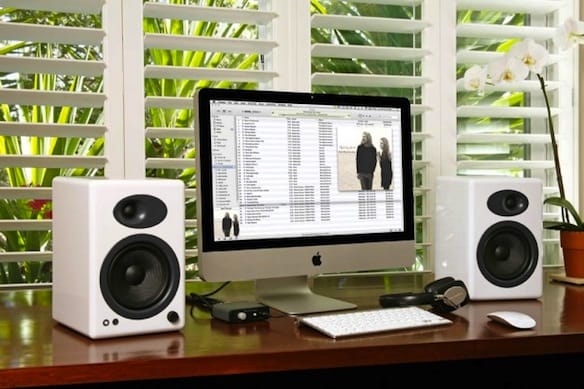
Image credit: Gadget Review.
Computer Speakers
Computer speakers, or multimedia speakers, are typically outboard speakers, often with an integral amplifier, that bypass the factory speaker in a computer when playing. Amplified speakers will also play from an array of sources, such as ipods, iphones, ipads, and digital music players. Some have RCA inputs for use with traditional stereos.
There is a great range of products available in this product class, from the speakers that might be included with a computer purchase (generally low fidelity) through sophisticated 5-way tuned wireless systems with integral digital-to-analog converters as well as amplifiers. As bass response becomes a critical criterion when considering small enclosures, subwoofers are part of many computer speaker configurations.
The burgeoning computer industry spawned a market demand that has lured some of the best speaker manufacturers into competition surrounding the smaller, compact computer speaker systems. Excellent product development is evident from such manufacturers as JBL, ALtec-Lansing, Klipsch, B/W, Boston Acoustics, Audioengine, Bose and NAD, to name a few. Priceonomics will peruse some options that will help you select the system for your purposes.
There are actually subclasses of computer speaker systems, some of which number 7 speakers in a configuration: wireless, multi-speaker, subwoofer, powered, USB-powered and those with other integral equipment, such as DACs, amplifiers and Bluetooth.
Powered versus not
Most outboard computer speaker systems use an integral amplifier to increase the line-level output of the computer to a level of current sufficient to drive the working parts of the speaker. There is a class of speakers powered by the 5 volt signal in a USB cable. In general these have lower performance ratings than powered speakers. There are also speakers with no amplification, like traditional stereo speakers, that require a stage amplifier between the computer and the speakers.
The question of whether or not a speaker is independently-powered is often answered with the jargon, passive or active, wherein active denotes the powered speaker. Some manufacturers offer a passive speaker, intended for use with an amplifier they also provide, such as the Peachtree DS4.5 speaker system (MSRP $599), which is advertised with a recommendation for use with their integrated amplifiers. Peachtree integrated amplifiers are listed on one supplier’s webpage as ranging from $820 to $4520, and though this is excellent gear, many potential users cringe at paying much more to produce good sound from a computer than the cost of the computer itself.
Products
This brings us to Audioengine, who offers an outboard integrated amplifier for under $200. Audioengine also offers some good alternatives for computer speakers, their A2 and A5+ powered speakers. The latter can be found for $399 and provides two discrete 50 watt amplifiers in the left speaker. The speaker components are shielded from field-bending video interference and include a ¾” diameter silk tweeter and a 5” Kevlar woofer. This product garners consistently positive reviews, as does their A2, with a integral 15-watt amplifiers, and features a similarly-shielded ¾” silk tweeter and a 2-3/4” Kevlar woofer. That’s right, the woofer is roughly one-half the size of the A5+. The A2 system retails for about $200 and also gets great user reviews.
This brings us to a good point of discussion: how much sound quality can come from how small of an enclosure? The technological objective of these computer speaker designs is in a constant struggle to get big sound from a small package, and though this is not technically nanoacoustics, as a science it qualifies as microacoustics. The development of long-throw speaker designs, non-rectangular enclosures, and the creative application of ports (holes) in the speaker cabinets to effectively “throw the voice” of the speaker, are all advents of computer speaker design.
Thus it would be an anticipated critique of the Audioengine A2, that its projection, at less than 1/3 of the wattage of the A5+ barely compares to that of its larger ported sibling. However, it is a viable argument, and selling point, that the A2 produces a “big sound” for a tiny speaker, and with its lower price point, is a more successful deployment of speaker microtechnology.
As we started with more expensive and elaborate options, a survey would not be complete without looking at the low end of the spectrum of computer speakers, where the JBL Jembe, retailing at $59 gets promising reviews. Logitech, at a similar price point gets consistently bad reviews. Altec-Lansing and Klipsch, both manufacturers with long-standing reputations make good solutions to this dilemma.
Multiple speakers, wireless convenience, remote control and cost will drive many decisions. Simplifying one’s desires for the individual application of computer speakers is the best course towards making a sound decision. Priceonomics will help you identify your dream computer speakers!



